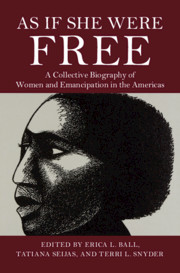Book contents
- As If She Were Free
- As If She Were Free
- Copyright page
- Dedication
- Contents
- Figures
- Contributors
- Elizabeth Catlett and the Form of Emancipation
- Acknowledgments
- Introduction
- Part I Claiming Emancipation during the Rise of New World Slavery
- 1 Margarita de Sossa, Sixteenth-Century Puebla de los Ángeles, New Spain (Mexico)
- 2 Paula de Eguiluz, Seventeenth-Century Puerto Rico, Cuba, and New Granada (Colombia)
- 3 Reytory Angola, Seventeenth-Century Manhattan (US)
- 4 Elizabeth Key, Seventeenth-Century Virginia (US)
- 5 Hannah Manena McKenney, Late Seventeenth- and Early Eighteenth-Century Bermuda and New Providence (Bahamas)
- 6 Juana de Godinez, Seventeenth-Century Lima (Peru)
- Part II Experiencing Freedom during Slavery’s Expansion
- Part III Envisaging Emancipation during Second Slavery
- Part IV Enacting Emancipation in the Aftermath of Slavery
- Bibliography
- Index
4 - Elizabeth Key, Seventeenth-Century Virginia (US)
from Part I - Claiming Emancipation during the Rise of New World Slavery
Published online by Cambridge University Press: 24 September 2020
- As If She Were Free
- As If She Were Free
- Copyright page
- Dedication
- Contents
- Figures
- Contributors
- Elizabeth Catlett and the Form of Emancipation
- Acknowledgments
- Introduction
- Part I Claiming Emancipation during the Rise of New World Slavery
- 1 Margarita de Sossa, Sixteenth-Century Puebla de los Ángeles, New Spain (Mexico)
- 2 Paula de Eguiluz, Seventeenth-Century Puerto Rico, Cuba, and New Granada (Colombia)
- 3 Reytory Angola, Seventeenth-Century Manhattan (US)
- 4 Elizabeth Key, Seventeenth-Century Virginia (US)
- 5 Hannah Manena McKenney, Late Seventeenth- and Early Eighteenth-Century Bermuda and New Providence (Bahamas)
- 6 Juana de Godinez, Seventeenth-Century Lima (Peru)
- Part II Experiencing Freedom during Slavery’s Expansion
- Part III Envisaging Emancipation during Second Slavery
- Part IV Enacting Emancipation in the Aftermath of Slavery
- Bibliography
- Index
Summary
Identity in seventeenth century colonial Virginia was in a liminal state. Enter Elizabeth Key, an African-Anglo woman living in the colony during the middle of the seventeenth century. Key sued for her freedom when the overseers of her late master’s estate classified her in the estate inventory as a negro rather than a servant. To the overseers the term negro implied a permanently or perpetually unfree person, an inheritable condition. In contrast, the term servant implied someone born free who voluntarily relinquished her freedom for a definite period. Thus, Key’s classification raised serious questions about her legal status and the status of at least one of her two children. Hers is one of the earliest freedom suits in the English colonies filed by a person with some African ancestry. Her representative argued that because her father was an English subject, she could not be enslaved for life. A negative consequence of her successful lawsuit was a law consigning the children of enslaved women to permanent servitude. In effect, Key’s attempt to emancipate herself from slavery and its concomitant forms of oppression resulted in larger changes to the racial status quo.
- Type
- Chapter
- Information
- As If She Were FreeA Collective Biography of Women and Emancipation in the Americas, pp. 79 - 95Publisher: Cambridge University PressPrint publication year: 2020

